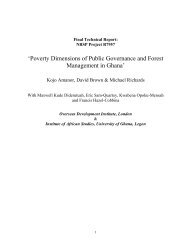The Gambian Tourist Value Chain and Prospects for Pro-Poor Tourism
The Gambian Tourist Value Chain and Prospects for Pro-Poor Tourism
The Gambian Tourist Value Chain and Prospects for Pro-Poor Tourism
You also want an ePaper? Increase the reach of your titles
YUMPU automatically turns print PDFs into web optimized ePapers that Google loves.
<strong>Tourism</strong> in <strong>The</strong> Gambia: International ‘Best Practice’ in Poverty Reduction & <strong>Pro</strong>-<strong>Poor</strong> Growth Through <strong>Tourism</strong><br />
Draft Report (Friday 22 nd December 2006)<br />
2 <strong>Tourism</strong> <strong>and</strong> Poverty<br />
<strong>The</strong> potential <strong>for</strong> tourism to accelerate economic growth <strong>and</strong> reduce poverty in many poor<br />
countries is gaining recognition. However, the negative impacts associated with tourism,<br />
such as reduced access to resources <strong>and</strong> negative social <strong>and</strong> cultural impacts 13 , sometimes<br />
threaten to overshadow the benefits that a vibrant tourism industry can generate.<br />
Box 1: Advantages of <strong>Tourism</strong> in Delivering <strong>Pro</strong>-<strong>Poor</strong> Growth<br />
• It is generally labour-intensive - although less than agriculture - <strong>and</strong> there<strong>for</strong>e can<br />
impact on a large number of lives through the labour market;<br />
• <strong>Tourism</strong> has considerable potential linkage especially with agriculture <strong>and</strong> fisheries,<br />
which can minimize the leakage effect. Due to the high income elasticity of<br />
dem<strong>and</strong> <strong>for</strong> international tourism, it can offer a relatively rapidly growing market.<br />
• <strong>Tourism</strong> provides opportunities <strong>for</strong> off-farm diversification, particularly in areas<br />
that do not attract other types of development options;<br />
• <strong>Tourism</strong> can provide poor countries with a significant export opportunities where<br />
few other options are viable;<br />
• It may create initial dem<strong>and</strong> <strong>for</strong> a good or service that can itself develop into a<br />
growth sector;<br />
• <strong>Tourism</strong> products can generate dem<strong>and</strong> <strong>for</strong> assets such as natural resources <strong>and</strong><br />
culture, to which the poor often have access;<br />
• <strong>Tourism</strong> delivers consumers to the product rather than the other way around; <strong>and</strong><br />
• Infrastructure associated with tourism development can provide essential services<br />
<strong>for</strong> rural communities.<br />
Source: <strong>Pro</strong>-<strong>Poor</strong> <strong>Tourism</strong> Working Paper No. 16. March 2004. pp 12-13.<br />
2.1 <strong>The</strong> Economic Significance of <strong>Tourism</strong><br />
Like most economic activities, international tourism is concentrated in the rich countries.<br />
However, in 2004 about one-third of international tourists arrived in a developing country.<br />
In the developing world, middle income countries capture the lions share of the<br />
international tourist market – although about 8% of international arrivals are in the poorest<br />
or Least Developed Countries (LDCs).<br />
Whilst small in terms of global share of the international tourism market, tourism has a<br />
disproportionate economic impact on very poor countries as Table 1 illustrates. Ironically,<br />
international tourism is often the primary export sector in many of the poorest countries in<br />
the world, with tourism generating significant export earnings <strong>for</strong> up to 80% of the 50 LDC 14 .<br />
<strong>The</strong> Gambia demonstrates a heavy reliance on tourism, even with comparatively low arrival<br />
numbers to other LDCs examined.<br />
13 <strong>Pro</strong>-<strong>Poor</strong> <strong>Tourism</strong> Info-Sheet 3: <strong>Tourism</strong> <strong>and</strong> Poverty Reduction – Making the Links re PPT Partnership<br />
14 Roe, D., Ashley, C., Page, S. <strong>and</strong> Meyer, D. (2004) “<strong>Tourism</strong> <strong>and</strong> the <strong>Poor</strong>: Analysing <strong>and</strong> Interpreting<br />
<strong>Tourism</strong> Statistics from a Poverty Perspective” <strong>Pro</strong>-<strong>Poor</strong> <strong>Tourism</strong> Partnership Working Paper No 16. PPT<br />
Partnership<br />
10

















